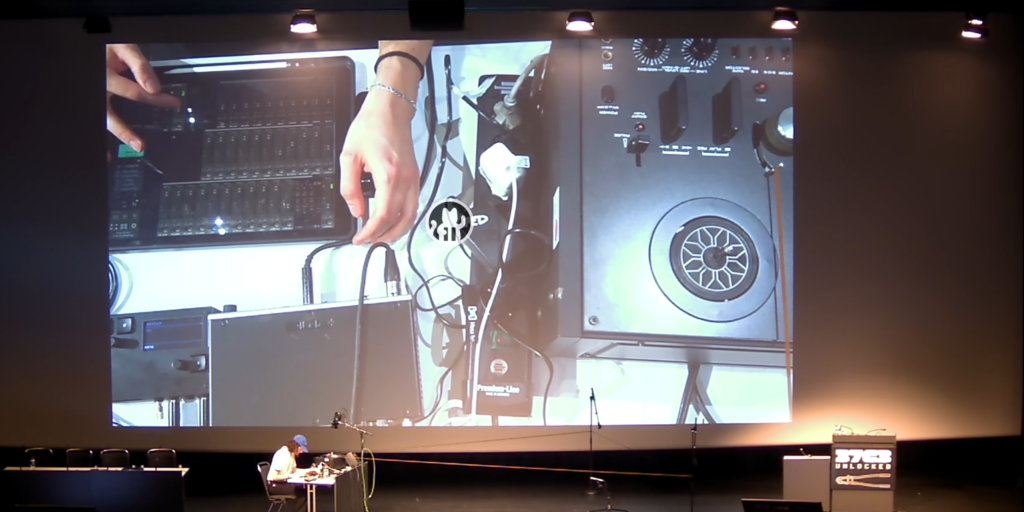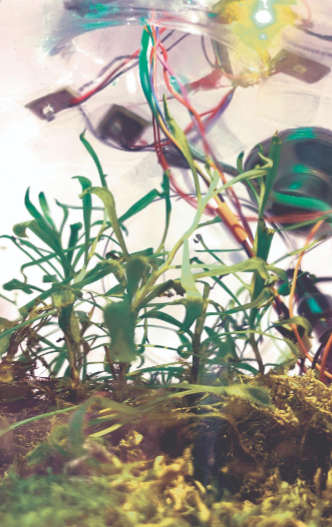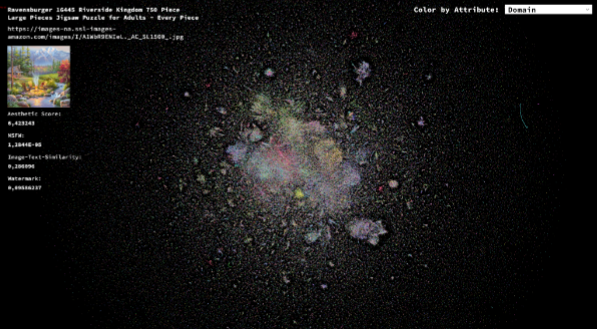KHM @ 37C3

…with Works, Performances and Talks from Bidisha Das, Anton Linus Jehle, Leon-Etienne Kühr, Ting Chun Liu, Pedro A. Ramirez, Lisa Reutelsterz
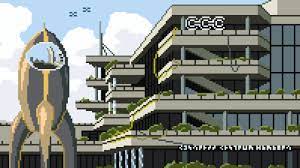
Congress offers lectures and workshops and various events on a multitude of topics including (but not limited to) information technology and generally a critical-creative attitude towards technology and the discussion about the effects of technological advances on society.
For 37 years, Congress has been organized by the community and appreciates all kinds of participation.
Works, Performances and Talks
Self-cannibalizing AI
Talk by Ting-Chun Liu & Leon-Etienne Kühr
Recording on media.ccc: https://media.ccc.de/v/37c3-12125-self-cannibalizing_ai
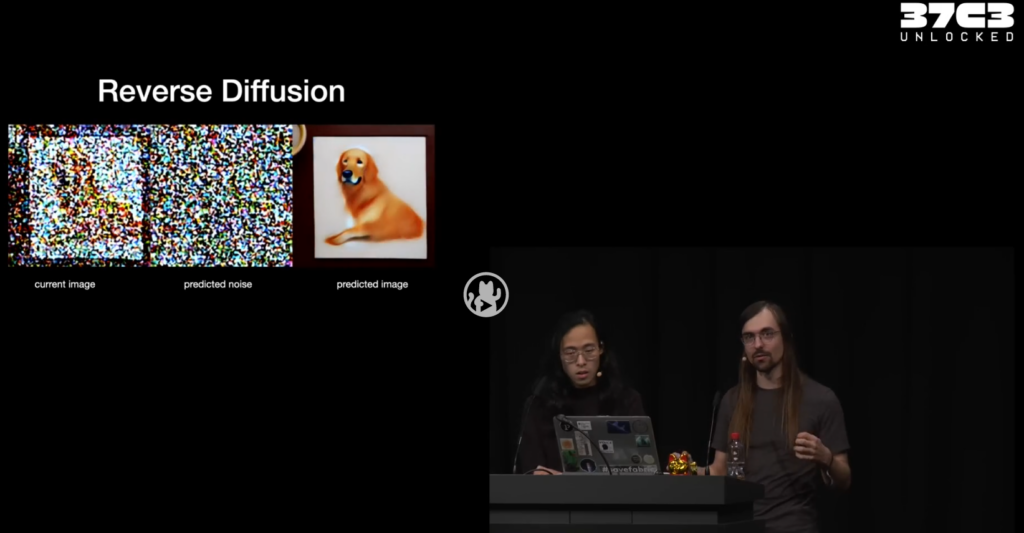
What occurs when machines learn from one another and engage in self-cannibalism within the generative process? Can an image model identify the happiest person or determine ethnicity from a random image? Most state-of-the-art text-to-image implementations rely on a number of limited datasets, models, and algorithms. These models, initially appearing as black boxes, reveal complex pipelines involving multiple linked models and algorithms upon closer examination. We engage artistic strategies like feedback, misuse, and hacking to crack the inner workings of image-generation models. This includes recursively confronting models with their output, deconstructing text-to-image pipelines, labelling images, and discovering unexpected correlations. During the talk, we will share our experiments on investigating Stable-Diffusion pipelines, manipulating aesthetic scoring in extensive public text-to-image datasets, revealing NSFW classification, and utilizing Contrastive Language-Image Pre-training (CLIP) to reveal biases and problematic correlations inherent in the daily use of these models.
Opencoil
Talk by Anton Linus Jehle & Dennis de Bel
Recording on media.ccc: https://media.ccc.de/v/37c3-12169-opencoil
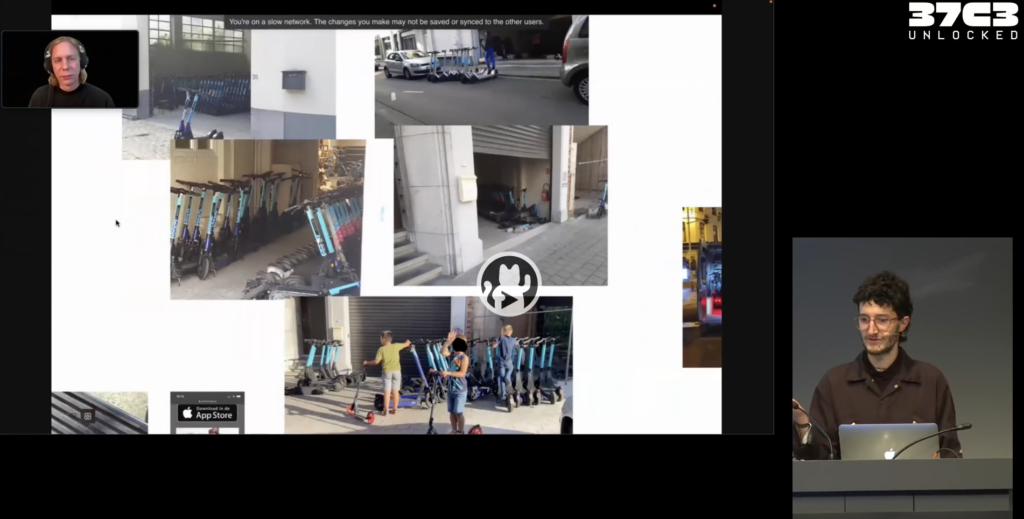
Since the dawn of deep mediatization (Hepp, 2020), the start-up scene posing as digital pioneers has been declaring a state of revolution, seeking nothing but disruption with the introductions of their products into society. A goal they definitely achieved with the introduction of micro-mobility services to our cityscapes / public space.
In 2020, Dennis de Bel and Anton Jehle therefore initiated the OPENCOIL research project to gain a better understanding of this latest venture capitalist phenomenon, share knowledge, establish a community, and develop tools to provoke a public debate. Later that year, they organized their first public intervention, the roaming speedshow, in Berlin and shared their insights with the community at rc3 (https://media.ccc.de/v/rc3-11575-opencoil_a_roaming_speedshow).
The ever changing landscape of micro-mobilty kept Speedy and Scooty invested and they are here at 37C3 to give an update on the OPENCOIL project! The term “revolution” has become a beloved buzzword for the platform economy. to take the world by storm: when in early 2018, thousands of electric kick scooters, or “trotinettes” as the french like to call them, flooded the city of Paris , the media sure was quick to coin this the “micromobility revolution” (Medium, 2018). As the french are somewhat experts in the field of revolutionizing, Paris is arguably the key to any successful uprising. The seemingly endless back and forth between regulation and cooperation, between sharing and exploiting, progress and regression of micromobility can be observed here like in no other European city. As of August 31st 2023, the trotinettes have been banned from the streets of Paris with almost 90 % of public votes supporting the decision. Today the Bastille square is completely freed from trottinettes: a revolution by the people.
With this years talk Scooty and Speedy will be problematising the rise (and fall) of shared mobility and its effects on the basis of Paris as well as related interventions and observations of the past three years.
Buffered Daemons
Performance by Pedro A. Ramirez
Recording on media.ccc: https://media.ccc.de/v/37c3-12138-buffered_daemons
The work titled Buffered Daemons(2023) is a sound installation with a performative activation that attempts to explore the concepts of translation and non-local interaction in the sound realm. It does so by playing with the idiosyncrasies of audio representation/playback and mobilizes them through the creation of an expanded musical situation. The work is inspired by the concept of daemon and non-locality explored by Timothy Morton in his reading of Plato’s Ion as well as Ursula K. Le Guin’s The Carrier Bag Theory of Fiction.
In the piece, three different containers of sound are presented: acoustic(Sound diffusion in the architecture), digital (computer based sound algorithms) and analogue (electromagnetic tape
and analog processing). These containers, or buffers, are then being intertwined by the performer
creating thus sonic textures that interplay with the resonances of the space.
Garden of Synchronicity 0.2 | Euclidean Sensemaking | [John and Mary] – by artificial and non-artificial systems
Art Show in FIfF Assembly with Leon-Etienne Kühr, Bidisha Das, Lisa Reutelsterz
Euclidean Sensemaking, Leon-Etienne Kühr
As datasets and machine-learning models continue to expand both in scale and complexity, the ability of humans to fully grasp the nuances, biases, and overall structures within them becomes increasingly challenging. To address this, techniques such as mappings and projections come into play, helping to reduce the overwhelming dimensionality of these spaces.
Since biases and relationships within these spaces can be highly dimensional and intricate, it becomes necessary to distill this complexity into metrics like distances between individual datapoints. While this process inevitably involves some information loss, the general neighborhood formed by these distances provides a valuable overview of the concepts located proximally to each other in the space.
Large datasets, like the one for training Stable Diffusion, are filtered using algorithms often employing machine learning. To “enhance” image generation, LAION’s extensive dataset underwent filtering with an aesthetic prediction algorithm that uses machine learning to score the aesthetics of an image with a strong bias towards watercolor and oil paintings. Besides the aesthetic scoring of images, images are also scored with an not safe-for-work classifier that outputs a probability of an image containing explicit content . This algorithm comes with its own discriminatory tendencies.
The interactive installation Euclidean Sensemaking delves into one such space and its associated mapping techniques. By leveraging algorithms for dimensionality reduction an interactive map is created that projects parts of the largest image-text-pair datasets that is used for many state-of-the-art image generators into a human readable map, full of biases and unexpected relations and mappings that represent a worldview shaped and reconstructed from internet-data.
Garden of Synchronicity 0.2, Bidisha Das
The Installation explores a speculative conversation between an infant AI (born 2022) generated landscape & an Earthly endangered Mangrove Forest, the ‘Sundarbans’ (born million years) which is located in Eastern India along the Ganges Delta. This is the largest Mangrove Forest in the world with an area of more than 10,000 sq kms. In the last decades, due to climate change and increased anthropocentric activities, the forest is constantly shrinking.
The traditional stories/songs of the indigenous people, the sounds of the forest, bird calls and the Bengal tiger’s blends with the imaginary AI landscape created by the machines. The limitless imagination of machines merges with the boundless imagination of nature, in a movement of their co-existing reality today in 2023. This is an installation with Plants. Sounds and electronics.
[John and Mary] – by artificial and non-artificial systems, Lisa Reutelsterz
Emotions and the feeling of pain are considered essential for our moral actions and our social interaction. How does a machine express itself with regard to this and what do we as viewers understand about it, or how? “[John and Mary] – by artificial and non-artificial systems” is an audiovisual experiment that blurs the boundaries between man, machine, natural and artificial systems, emotions and their machine reproduction.
Poems were generated using a large language model (LLM) and then read into image diffusion models to create synthetic videos. These were presented to authors without context to capture their individual interpretation of the videos, which can be heard in VoiceOver. Within dreamlike sequences, a maelstrom is created that seduces one to grasp meaning in the images, revealing a tension between machine and human semantics.
more Info (coming soon) here: https://events.ccc.de/congress/2023/hub/en/assembly/fiff/

